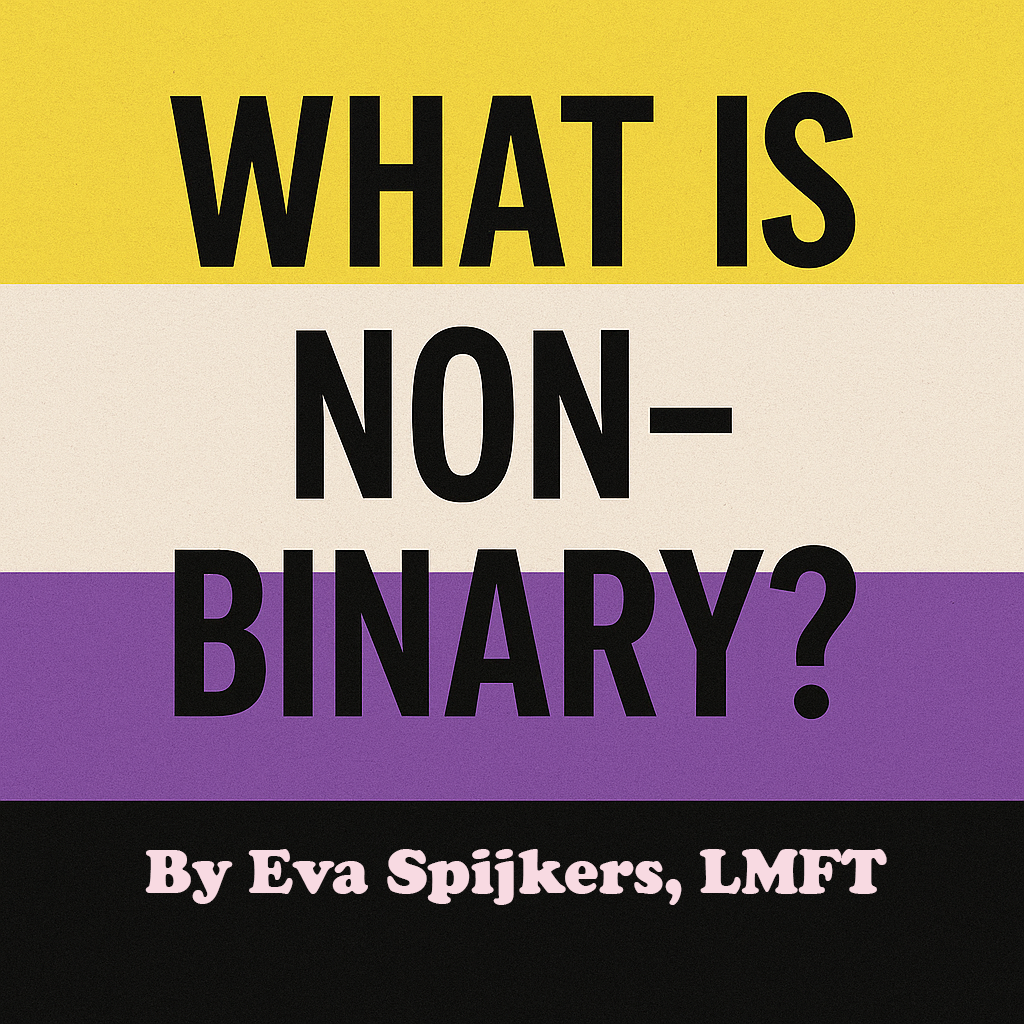What Is Non-Binary? And Why the Gender Binary Was Never the Whole Story
By Eva Spijkers, LMFT
If you’ve never heard of the term non-binary or if it just sounds like the latest buzzword in a long list of identities, you’re not alone. But here’s the truth: non-binary people aren’t new, and neither is the idea that gender is more than “man or woman.” What is new—for many in the West—is the growing recognition that the male/female binary we take for granted is not a biological fact but a social framework. One that has shifted across time, culture, and context.
Let’s clear something up: sex and gender are not the same thing. You’ve probably heard people use these words interchangeably, as if they mean exactly the same thing. But they don’t—and understanding the difference is key to making sense of conversations about identity, equality, and human dignity.
Sex is what doctors usually assign at birth based on physical traits like genitals, chromosomes, and hormones. This is where labels like “male” or “female” come from. But even here, things aren’t as simple as we’ve been led to believe. Some people are born intersex—with a mix of sex characteristics that don’t fit neatly into “male” or “female” boxes. This isn’t rare, and it’s not new. It’s just something we’ve been trained not to see (see more on this topic here).
Gender, on the other hand, is something we learn, perform, and express. It’s the social and cultural roles we’re expected to play based on our assigned sex. Think of it this way: being assigned male at birth might come with the expectation that you’ll like trucks, avoid crying, and never wear a dress. Being assigned female might come with the opposite set of expectations. We’re told that gender is “natural.” But if it were purely biological, wouldn’t it be the same everywhere, always? Instead, history is filled with evidence that gender norms are anything but fixed.
In 18th-century Europe, for instance, elite men wore powdered wigs, makeup, and high-heeled shoes. Being a dashing womanizer often meant dressing in what we’d now consider highly “feminine” clothing. Pink, now coded as “girly,” was once a color for fashionable boys. Even in our own lifetimes, the rules have changed. Women wearing pants to work was once scandalous. Now it’s expected. Masculinity and femininity are moving targets—and they always have been.
Gender changes. Not just across generations, but across cultures, too.
Looking beyond the West, many cultures have long recognized more than two genders. The Hijra of South Asia, who have been part of Indian society for centuries, are officially recognized as a third gender. In Indigenous North American cultures, Two-Spirit people held respected roles that blended or moved beyond male and female categories. These identities aren’t anomalies—they are integrated parts of the community.
Now, let's get into what non-binary means. A non-binary person is someone who doesn’t identify exclusively with the Western idea of man or a woman. This doesn’t mean they’re confused, seeking attention, or that they want to erase gender altogether. It means they reject the idea that there are only two ways to be a person when it comes to gender. And once you realize that the gender binary is a product of culture, not nature, that rejection starts to make a lot more sense.
Let’s be clear: being non-binary isn’t about rejecting the body or erasing sex—it’s about reclaiming the right to define yourself beyond someone else’s rules. Non-binary people aren’t saying they have no gender; they’re saying their experience of gender doesn’t fit neatly into the boxes we’ve been taught to accept as the only two options. Labels like “he” or “she” often carry a heavy load of expectations—how to dress, how to behave, how to exist in the world. For many non-binary people, those labels feel more like costumes than reflections of truth. Choosing a different identity, or different pronouns, isn’t about confusion. It’s about clarity—the clarity that comes from saying, this is who I am, not who I was told I had to be.
Of course, one of the most common pushbacks against non-binary identities comes in the form of a grammar complaint: “But ‘they’ is plural!” It’s a familiar refrain, usually delivered with more indignation than concern for sentence structure. But here’s the thing: English has used they as a singular pronoun for centuries. We do it all the time without thinking—“Someone left their umbrella” or “Tell the next caller they’ll need to wait.” It’s only when they is used for a known person that people suddenly claim confusion. But grammar isn’t a fixed law—it evolves with how people use language. And beyond English, many languages don’t even have gendered pronouns to begin with. Turkish, Tagalog, and spoken Chinese all use a single word for “he” and “she,” without any loss of clarity or civility. So when people insist that English must cling to gendered pronouns, they’re not defending grammar—they’re defending a cultural habit. Think about that next time you talk about your cousin.
So if someon tells you they’re non-binary, or that they prefer “they/them” pronouns, they’re not inventing something out of thin air. They’re participating in a rich, global, and historical tradition of pushing back against artificial rules about how people should act based on what’s in their pants. They’re saying: “I don’t fit into the categories you’ve created—and maybe those categories never fit anyone perfectly anyway.”

